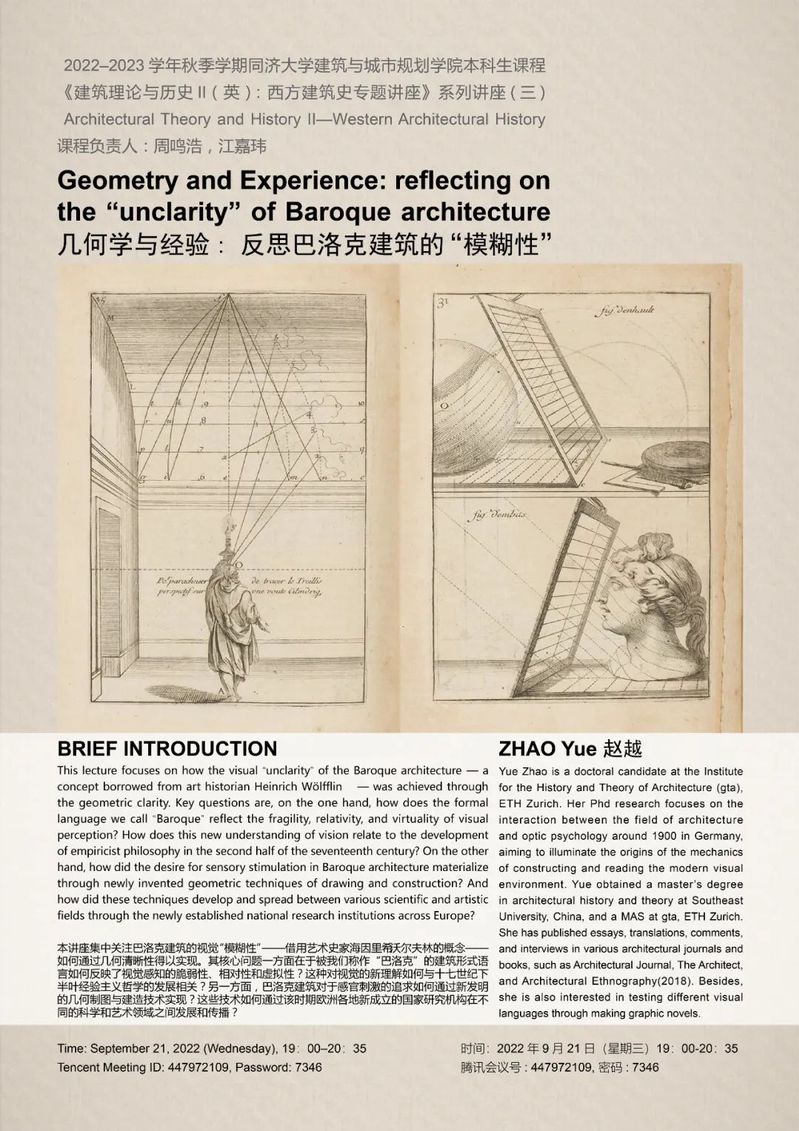新闻中心



建筑理论与历史Ⅱ(英): 西方建筑史专题讲座
Architectural Theory and History Ⅱ: Western Architectural History
Geometry and Experience: reflecting on the “unclarity” of Baroque architecture
几何学与经验: 反思巴洛克建筑的“模糊性”

主讲人
ZHAO Yue 赵越
Yue Zhao is a doctoral candidate at the Institute for the History and Theory of Architecture (gta), ETH Zurich. Her Phd research focuses on the interaction between the field of architecture and optic psychology around 1900 in Germany, aiming to illuminate the origins of the mechanics of constructing and reading the modern visual environment. Yue obtained a master’s degree in architectural history and theory at Southeast University, China, and a MAS at gta, ETH Zurich. She has published essays, translations, comments, and interviews in various architectural journals and books, such as Architectural Journal, The Architect, and Architectural Ethnography(2018). Besides, she is also interested in testing different visual languages through making graphic novels.
赵越是苏黎世联邦理工学院建筑历史与理论研究所(gta)的博士候选人。她的博士研究关注1900年前后德国建筑与视觉心理学领域之间的互动,旨在阐明构建和阅读现代视觉环境的机制性起源。她先后在东南大学和苏黎世联邦理工学院获得建筑历史和理论硕士学位,并在各种建筑期刊和书籍中发表过论文、翻译、评论和访谈,如《建筑学报》、《建筑师》和《建筑民族志》(2018)。此外,她还对通过制作图像小说测试不同的视觉语言感兴趣。
讲座时间
Time: September 21, 2022 (Wednesday), 19:00–20:35
时间:2022年9月21日(星期三)19:00-20:35
参与方式
Tencent Meeting ID: 447972109, Password: 7346
腾讯会议号: 447972109, 密码: 7346
讲座简介
This lecture focuses on how the visual “unclarity” of the Baroque architecture — a concept borrowed from art historian Heinrich Wölfflin — was achieved through the geometric clarity. Key questions are, on the one hand, how does the formal language we call Baroque reflect the fragility, relativity, and virtuality of visual perception? How does this new understanding of vision relate to the development of empiricist philosophy in the second half of the seventeenth century? On the other hand, how did the desire for sensory stimulation in Baroque architecture materialize through newly invented geometric techniques of drawing and construction? And how did these techniques develop and spread between various scientific and artistic fields through the newly established national research institutions across Europe?
本讲座集中关注巴洛克建筑的视觉“模糊性”——借用艺术史家海因里希·沃尔夫林的概念——如何通过几何清晰性得以实现。其核心问题一方面在于被我们称作“巴洛克”的建筑形式语言如何反映了视觉感知的脆弱性、相对性和虚拟性?这种对视觉的新理解如何与十七世纪下半叶经验主义哲学的发展相关?另一方面,巴洛克建筑对于感官刺激的追求如何通过新发明的几何制图与建造技术实现?这些技术如何通过该时期欧洲各地新成立的国家研究机构在不同的科学和艺术领域之间发展和传播?
参考文献
Primary literature
1. Bosse, Abraham. Manière universelle de Mr. Girard Desargues, pour pratiquer la perspective par petit-pied, comme le geometral. Paris, 1648.
2. Pozzo, Andrea. Perspectiva pictorum et architectorum Andreae Putei e Societate Jesu. Pars Prima. Romae, 1693.
3. Guarini, Guarino. Architettura Civile del Padre D. Guarino Guarini. Cherico Regolare opera postume dedicata a Sua Sacre Reale Maesta. Torino, 1737.
Secondary literature
4. Wölfflin, Heinrich. Renaissance und Barock. München, 1888. (en. tr. Renaissance and Baroque, New York: Cornell University Press 1967).
5. Baxandall, Michael. Patterns of Intention. On the Historical Explanation of Pictures. Yale University Press, 1985.
6. Evans, Robin. The Projective Cast. Architecture and Its Three Geometries. Cambridge, Mass.: The MIT Press, 1995.
7. Hersey, George L.. Architecture and Geometry in the age of Baroque. Chicago/London: The University of Chicago Press, 2000.
8. Gal, Ofer and Raz Chen-Morris(eds.). Science in the Age of Baroque. Springer Netherlands, 2012.
9. Oechslin, Werner, “On Borromini’s drawings and “practical geometry”: voleva dentro una cosa cavare un’altra, e nell’altra l’altra senza fi nire mai.” Mansure, Adil and Skender Luarasi(eds.), Finding San Carlino. Collected Perspectives on the Geometry of the Baroque. London/New York: Routledge, 2020: 8-24
海报图片来源
Bosse, Abraham. Moyen universel de pratiquer la perspective sur les tableaux ou surface irregulieres. Paris, 1653.